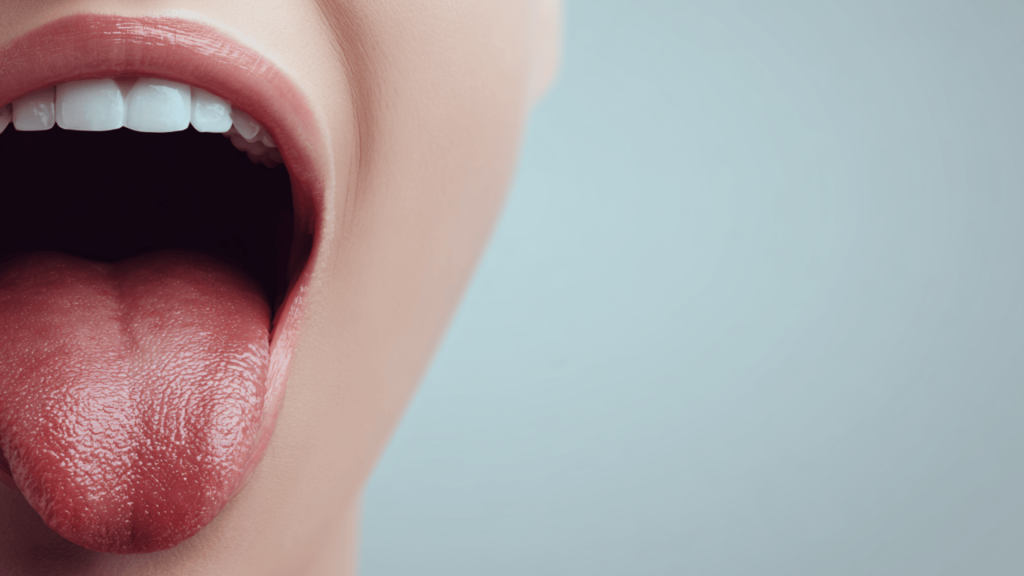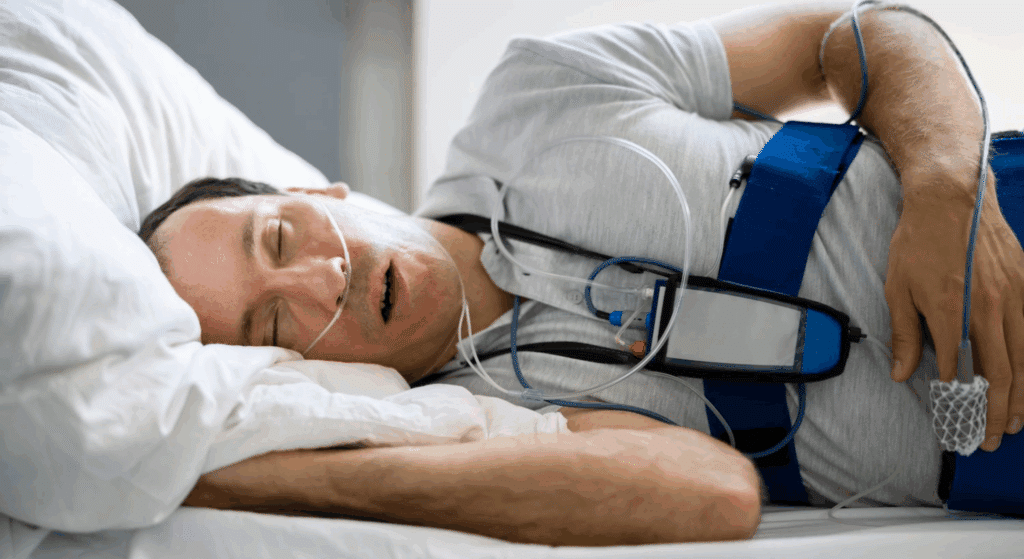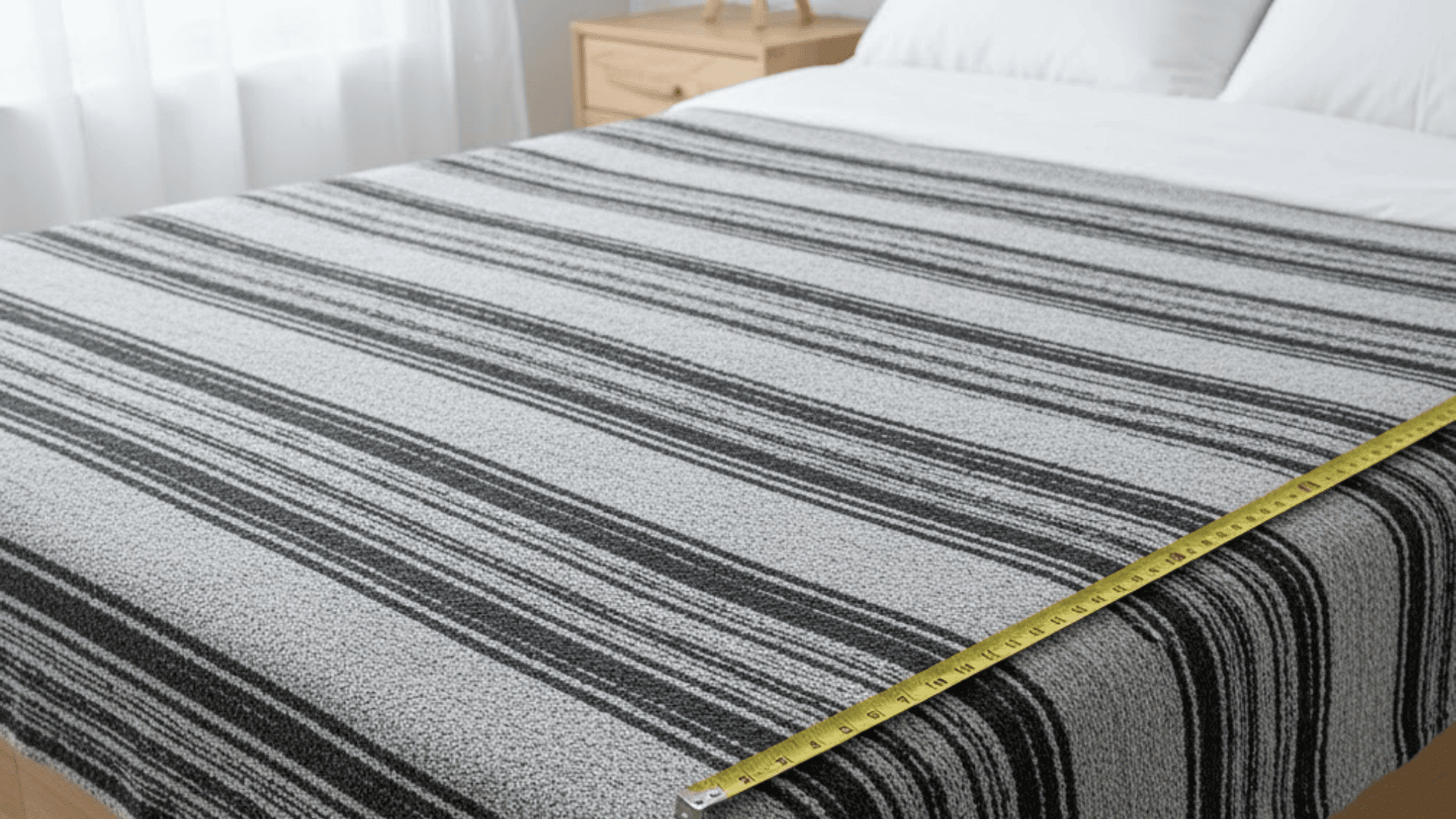Ever looked at your tongue in the mirror and thought, “Something doesn’t look right?” I’ve had that moment too. Maybe your tongue feels swollen, dry, or has ridges along the edges. What you might not realize is that these subtle changes could be your body’s way of flagging a deeper issue, like sleep apnea.
I’ll walk you through the most common tongue signs of sleep apnea in simple, clear terms. You’ll learn what to watch for, why it matters, and when it’s time to talk to your doctor or dentist.
I will also cover how sleep apnea is diagnosed, what treatments are available, and a few easy tips that can make a real difference. By the end, you’ll know how to spot early signs and take the next step.
Let’s find out what your tongue is trying to tell you about your sleep together.
Why the Tongue Matters in Sleep Apnea
Your tongue plays a bigger role in your breathing than you might think, especially while you’re asleep.
Anatomy of the Airway and Tongue Placement
The tongue sits in the lower part of your mouth, just behind your teeth. When you’re awake, muscles around it keep it in place.
But during sleep, these muscles relax. If your tongue is large or not positioned well, it can fall back and block your airway.
This blockage happens mostly in the throat, where your airway is narrow and soft.
How the Tongue Contributes to Airway Obstruction During Sleep
When the tongue slides backward during sleep, it can press against the soft tissues in your throat. This narrows the space where air passes through.
If the airway gets too tight, airflow slows down or stops completely, this is called obstructive sleep apnea.
Here’s how the tongue can block the airway:
- Large or fat-filled tongue: Common in people with obesity.
- Poor tongue posture: Occurs when the tongue rests too low in the mouth.
- Jaw and tongue mismatch: A small jaw can’t hold the tongue properly.
- Muscle relaxation during sleep: Especially during deep sleep or while lying on your back.
The result? Snoring, gasping, or long pauses in breathing that disturb your sleep.
Common Tongue Signs of Sleep Apnea
If you take a close look at your tongue, you might spot signs that something’s off with your breathing during sleep. These signs aren’t always obvious, but they can give helpful clues when it comes to spotting sleep apnea early.
1. Scalloped or Indented Tongue
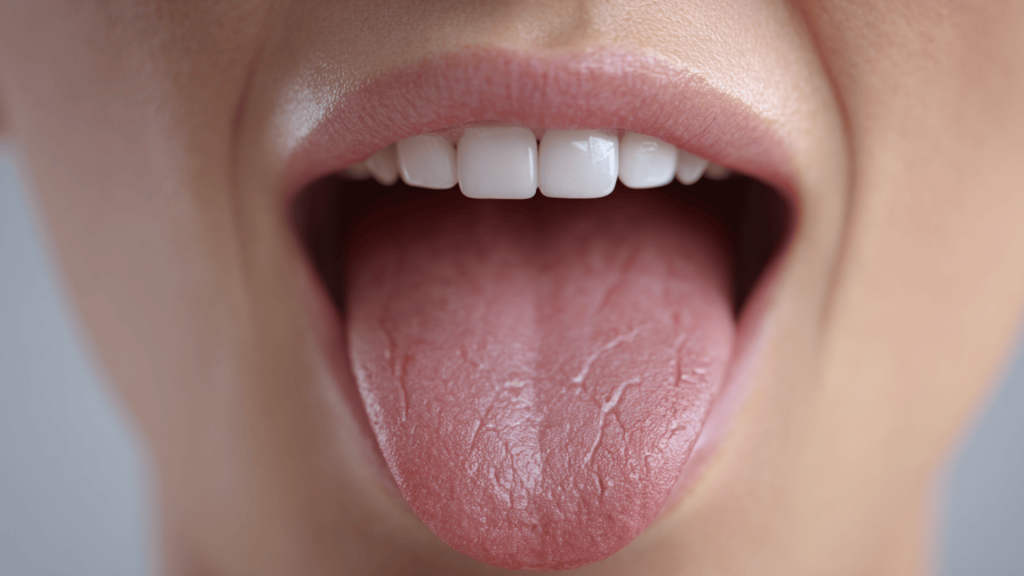
A scalloped tongue has ridges or waves along the edges. These marks usually line up with your teeth.
They appear when your tongue presses against your teeth during sleep, often as it shifts forward to keep your airway open. Over time, this repeated pressure leaves behind those scalloped impressions, which are a common sleep apnea tongue sign.
2. Swollen or Enlarged Tongue
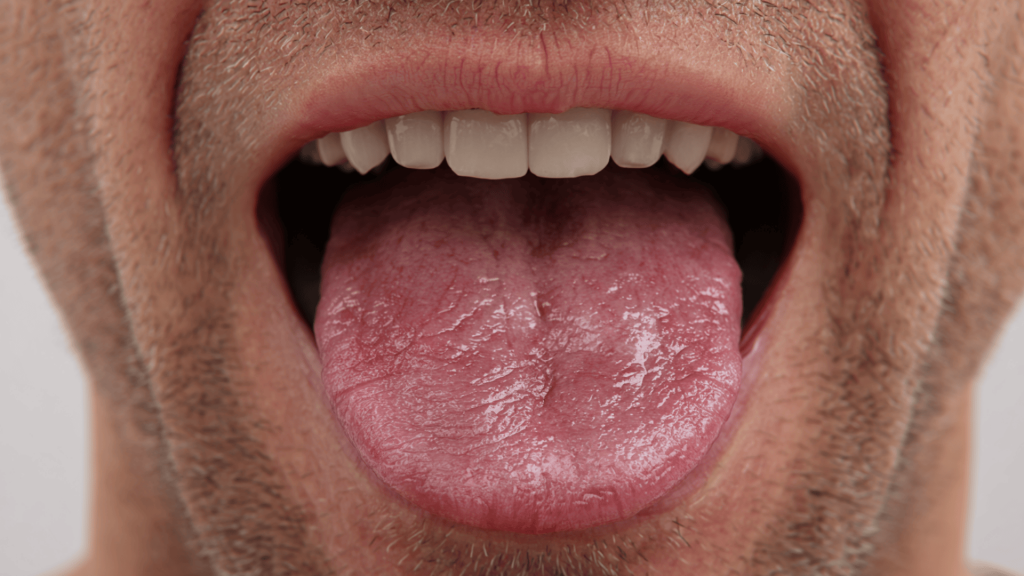
If your tongue looks puffier than usual when you wake up, it might be due to blocked airflow during the night.
A swollen tongue can happen when it’s pressed backward into the throat, especially while lying on your back. This pressure limits space in the airway and can cause it to feel full or tight in the morning.
3. Dry or Rough Tongue Surface
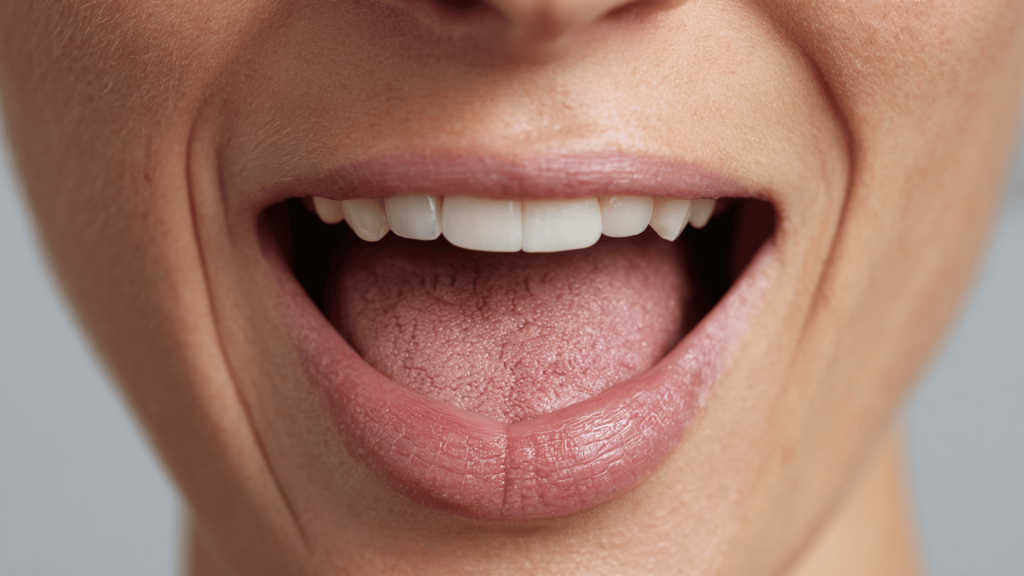
People with sleep apnea often breathe through their mouths while sleeping. This dries out the tongue and can make it feel rough, sticky, or cracked.
You may also wake up with a dry mouth, sore throat, or bad breath. These signs usually mean your body is struggling to get enough air through the nose at night, which adds to the sleep apnea tongue pattern.
4. Redness, Bumps, or Irritation
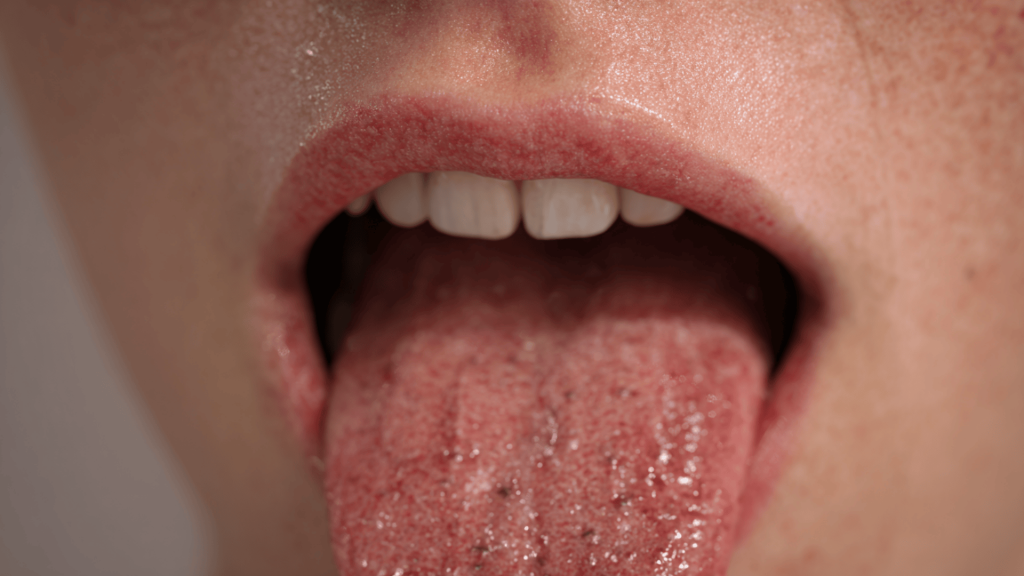
Some people notice red patches, sore spots, or a bumpy texture on their tongue.
This irritation can come from friction, dryness, or muscle tension while sleeping. It’s not always painful, but it may be a sign your tongue is shifting in unusual ways to keep your airway open.
5. Tongue That Feels Too Big for the Mouth
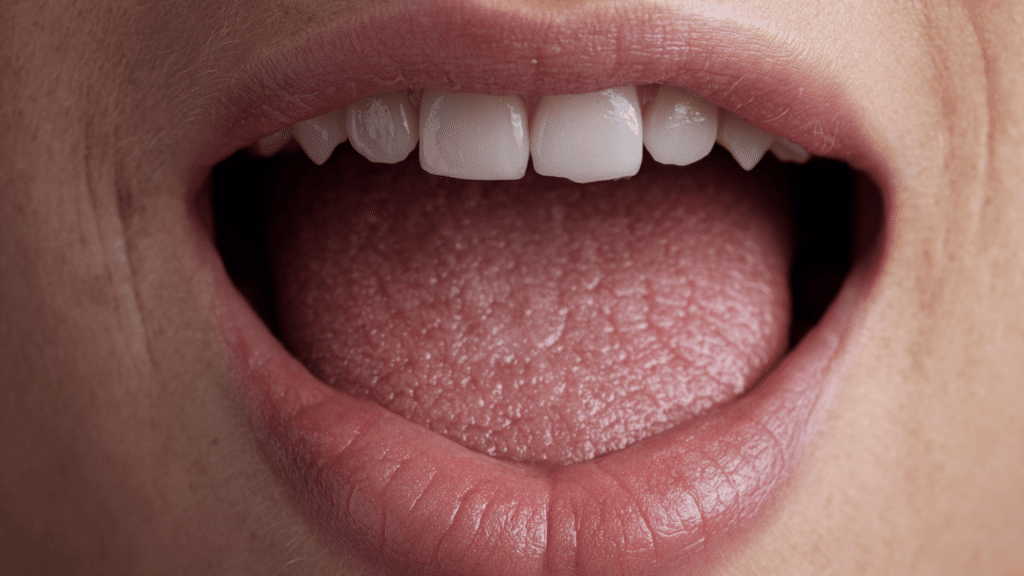
If your tongue feels oversized or crowded in your mouth, especially at night, it may be part of the problem.
A large tongue with sleep apnea can easily slide back during sleep and block airflow. Even if it looks normal during the day, it can still cause trouble once your muscles relax.
Tongue Changes vs. Other Conditions
Not all tongue changes are caused by sleep apnea. Some can come from everyday habits, diet, or other health issues. It’s important to know the difference so you don’t jump to conclusions.
Here are a few common causes that can look similar to sleep apnea tongue signs, but may have different explanations:
Teeth Grinding (Bruxism)
Grinding or clenching your teeth at night can also cause scalloped edges on the tongue. The pressure pushes the tongue into the teeth, leaving ridges behind.
This can look just like a sleep apnea tongue, but it’s more about jaw tension than breathing problems.
Vitamin Deficiencies
A swollen or sore tongue may be linked to low levels of certain vitamins, like B12 or iron.
In these cases, you might also notice burning, a smooth tongue surface, or a pale color. These signs usually show up throughout the day, not just in the morning.
Dehydration
When your body lacks enough water, the tongue may become dry, cracked, or coated.
This can look similar to mouth-breathing effects but is often tied to overall fluid loss, not airway problems during sleep.
TMJ or Jaw Misalignment
If your jaw doesn’t align properly, it can put pressure on the tongue or cause it to rest in unusual positions. This can lead to irritation, tension, or scalloping, even if your breathing during sleep is normal.
Knowing the difference helps you decide whether to see a sleep specialist, a dentist, or your primary doctor. If you’re unsure, start by noting when the changes appear and if they come with other symptoms like snoring, dry mouth, or fatigue.
When to Seek Medical Help

If you’re seeing tongue changes and think sleep apnea might be the cause, don’t wait too long to take action. Paying attention to a few key signs can help you know when it’s time to speak with a professional.
Other Signs That Strengthen Suspicion of Sleep Apnea
Tongue symptoms are just one piece of the puzzle. When combined with other warning signs, the chances of sleep apnea become stronger.
Look out for:
- Loud snoring or gasping during sleep
- Waking up often through the night
- Feeling tired even after a full night’s sleep
- Morning headaches or dry mouth
- Trouble focusing during the day
- Mood changes or irritability
When tongue signs show up alongside these issues, it’s a good idea to get checked out.
Role of Dentists and Oral Health Professionals
Dentists are often the first to notice early signs of sleep apnea, especially if you’re visiting for regular cleanings or jaw issues.
They can spot things like tongue scalloping, a narrow airway, or other mouth features that hint at poor breathing during sleep. Many dentists now screen for sleep issues and may ask about your sleep habits or symptoms.
If they notice a problem, they can guide you on what to do next.
Referral to a Sleep Specialist
If your dentist or doctor suspects sleep apnea, they may refer you to a sleep specialist.
A sleep specialist can recommend a test to track your breathing overnight. This can be done at home or in a clinic, depending on your symptoms.
From there, you’ll get a clear diagnosis and a treatment plan that fits your needs, whether it’s lifestyle changes, a device, or another type of support.
Diagnosis and Treatment Options
If you or your dentist suspect sleep apnea based on tongue signs or other symptoms, the next step is proper testing. Getting diagnosed is key to finding a treatment that works for you.
1. Home Sleep Apnea Tests
A home sleep test is a simple way to check your breathing while you sleep in your own bed.
You wear a small device that tracks things like airflow, heart rate, and oxygen levels. It’s easy to use and often the first step in diagnosing mild to moderate cases.
2. In-Clinic Sleep Studies
If your symptoms are more complex, a full sleep study at a clinic might be recommended.
This test, called a polysomnography, gives a more detailed picture of your sleep patterns. It tracks brain activity, breathing, oxygen levels, and muscle movement through the night.
It’s done under medical supervision and is best for catching more severe or unclear cases.
3. CPAP vs. Oral Appliances
If you’re diagnosed with sleep apnea, one common treatment is a CPAP machine. It gently pushes air through a mask to keep your airway open all night.
For people who can’t tolerate a CPAP, a custom oral appliance is another option. This small mouthguard moves your jaw or tongue forward to make more space in your airway.
Both can help reduce snoring, improve sleep, and ease daytime fatigue.
4. Surgery and Lifestyle Modifications
In some cases, surgery might be needed to fix a blocked airway. This could involve removing tissue from the throat or adjusting the position of the jaw or tongue.
Lifestyle changes like losing weight, changing sleep positions, or cutting alcohol before bed can also make a big difference, especially if the tongue is part of the blockage.
5. Myofunctional Therapy or Tongue Positioning Devices
Some people benefit from tongue and throat exercises, known as myofunctional therapy. These exercises help strengthen muscles that support your airway during sleep.
There are also devices that hold your tongue forward while you sleep. These are small, simple tools that may help reduce snoring and improve breathing, especially if you have a large or floppy tongue.
Prevention and Management Tips
Some small changes in your routine can help reduce tongue-related airway issues and improve your sleep. While these tips aren’t a cure, they can support your overall treatment plan and ease mild symptoms.
- Side-sleeping instead of back-sleeping: Lying on your back makes it easier for the tongue to fall into the throat. Sleeping on your side gives your airway more space and reduces the chance of blockage.
- Losing extra weight around the neck and tongue: Extra fat tissue, especially around the throat or tongue, can narrow your airway. Shedding even a small amount of weight can help relieve pressure on your airway.
- Avoiding alcohol and sedatives before bed: These relax your muscles more than usual, including the ones that keep your tongue in place. Skipping them in the evening may help you breathe better overnight.
- Doing tongue and throat exercises daily: Simple routines like pushing your tongue against the roof of your mouth or repeating certain sounds can strengthen the muscles involved in breathing.
- Trying a tongue stabilizing device while sleeping: These small tools hold your tongue forward gently during sleep. They’re quiet, easy to wear, and don’t require electricity like a CPAP machine.
Even if your symptoms are mild, taking these steps can support better sleep and may prevent things from getting worse. If you don’t notice improvement, talk to your doctor for more targeted options.
Wrapping Up
Noticing tongue signs of sleep apnea can be a helpful way to catch potential sleep problems early, and I’m glad you took the time to learn what to watch for. Now that you know what these signs might look like, take a minute to think about how they show up in your daily life.
I’ve found that even small changes in the shape, color, or tension of the tongue can point to bigger issues with breathing or rest. If something feels off, don’t ignore it.
If this post gave you some helpful insights, I’ve got more for you. Check out my other blogs for simple tips on sleep, wellness, and everyday health habits that really make a difference.


